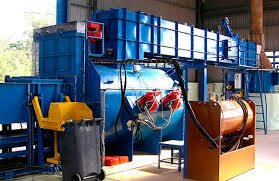Purpose
The primary purpose of an MSW incinerator is to convert municipal solid waste into energy, typically in the form of heat and electricity. By incinerating the waste, the facility reduces its volume, minimizes the need for landfill space, and generates renewable energy.
Waste Types
MSW includes a wide range of materials, such as food waste, paper, plastics, textiles, glass, metals, wood, and other non-hazardous household and commercial waste. MSW incinerators are designed to handle this diverse waste stream efficiently.
Incineration Process
MSW incineration involves the combustion of waste at high temperatures, typically ranging from 800 to 1,200 degrees Celsius (1,472 to 2,192 degrees Fahrenheit). The heat generated from the combustion process is used to produce steam, which drives turbines to generate electricity. The remaining ash is often processed and disposed of in a landfill.
Energy Recovery
One of the key advantages of MSW incinerators is the recovery of energy from the waste. The heat produced during incineration can be converted into steam, which drives turbines connected to generators to produce electricity. This process contributes to the generation of renewable energy and reduces the reliance on fossil fuels.
Air Pollution Control
MSW incinerators are equipped with advanced air pollution control systems to minimize emissions and ensure compliance with strict environmental regulations. These systems include technologies such as scrubbers, filters, and electrostatic precipitators to remove particulate matter, acid gases, and other pollutants from the flue gases before they are released into the atmosphere.
Residue Management
After incineration, the remaining ash is typically processed and managed according to specific regulations. This may involve treating the ash to reduce its volume and stabilize any potentially harmful substances before disposal in a landfill.
It’s important to note that MSW incineration is often seen as part of an integrated waste management system that includes waste reduction, recycling, and composting. The decision to implement an MSW incinerator should consider local waste management practices, environmental impact assessments, and the overall energy and waste management goals of the community or region.
Our incinerators are designed and constructed for processing of hazardous, chemical, toxic, medical and infectious waste materials. In fact, they are built for thermal treatment of most difficult wastes and can be easily applied fo
Hazardous waste include various materials such as toxic chemicals, solvents, pesticides, heavy metals, flammable liquids, contaminated solid, Sludge, and liquids waste can comprise hazardous materials like plastics, paper, wood, API waste, pharmaceuticals, solvent-based paints, pesticides, motor oils, oily rags and other waste generated by manufacturing, construction, and other industrial processes. We’ll guarantee our incinerator can discard all modern waste and can surpass every one of your assumptions concerning limit, result and cost adequacy.
Hazardous wastes are those that may contain toxic substances generated from industrial, hospital, some types of household wastes. These wastes could be corrosive, inflammable, explosive, or react when exposed to other materials.
Saincraft is the leading Best Hazardous Waste Incinerator & Industrial Waste Incinerator manufacturer in India. Our incinerators have the option of wet or dry air pollution control in the form of cyclone separators, fabric filters, ceramic filters, low-pressure wet scrubbers, and electrostatic precipitators.
Hazardous waste can be defined by certain parameters like reactivity, toxicity, and irritability. Examples of some hazardous wastes are obsolete computer equipment, pharmaceuticals, solvent-based paints, pesticides, batteries, motor oils, oily rags etc.
Incineration purposes ignition to make irresistible modern waste innocuous and decrease the waste mass and volume by in excess of 90%. Appropriate incineration can change over specific wastes into gases and incombustible strong buildups (e.g., debris) that are somewhat innocuous. A double chamber INDUSTRIAL INCINERATOR worked inside the ideal temperature scope of 850° to 1200°C outcomes in a lower level of discharges. The gases from incineration are delivered into the environment (regardless of gas cleaning). Buildup debris from legitimate incineration can be epitomized in assigned debris pits or controlled landfills with no significant gamble.
In any case, when the circumstances are not sufficient – for instance when the waste isn’t as expected isolated or the incinerator isn’t as expected built or worked – poisonous mixtures can be found in the unburned waste, and harmful gases can be delivered into the air. Great preparation, specialized oversight, and supported strong management of incinerator frameworks are basic to guaranteeing safe burning. Waste incineration plants are worked so as to accomplish a degree of burning with the end goal that the all-out natural carbon content of slag and base cinders is under 3% or their misfortune on start is under 5% of the dry load of the material.
Each AIR POLLUTION CONTROL EQUIPMENTS industry is unique, however, they all offer one thing in like manner. Industrial facilities and assembling plants of every kind create misuse of some sort. Discarding it really is a common test. Modern waste fluctuates emphatically in size, content and calorific worth. Different waste sorts should be discarded in various ways, for them to be securely and safely wiped out. Industrial facilities and assembling plants of every kind imaginable produce misuse of some sort. Discarding it really is a common test. We can assist you with tracking down the right incinerator to match your requirements. ROTARY KILN INCINERATORS come in all shapes and sizes, so we will work intimately with you to track down the right one that fits inside your ongoing offices.
It is a controlled air incinerator, offering ideal ignition conditions for various waste sorts. Its top-stacking configuration offers fluid maintenance, making this incinerator ideal for the incineration of various different waste streams.







